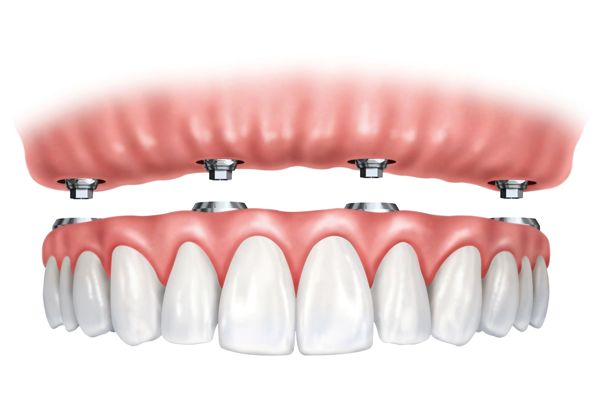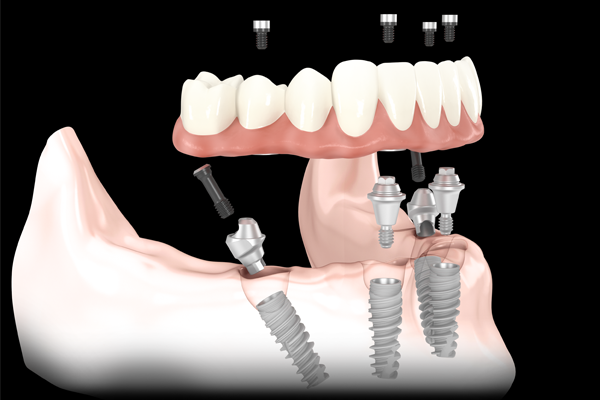Implant Supported Bridges
Implant-supported bridges are similar to a regular dental bridges, the only difference is supported by implants but not by natural teeth. When implant-supported bridge is used, one implant is placed in the jawbone for each missing tooth and the crowns are connected to each other to form a piece.
When you should go for Implant supported bridges?
If more than one tooth is missing, then you should opt for implant-supported bridges. The procedure can also be opted when there is a chance of putting too much of pressure on individual implants. Putting too much of pressure can increase the chances of teeth loosening from the bone and fail. An implant supported bridge can decrease the pressure on the individual implants in the bone and spreads across the entire bridge.
When the implants are placed next to natural teeth, the surrounding gums should be in good health. If you don’t have adequate bone to support the dental implants, the supporting bone can be built through bone augmentation or grafting procedure.

Implant supported bridge procedure
If you don’t have enough jawbone to support an implant or may be the location is close to a nerve or sinus cavity, then your dentist may not put an implant in your mouth. In this case, implants will be placed on both the sides of the space. An implant-supported bridge will be placed on top.
Implants are made of titanium and placed in the jawbone. You can have one implant for each missing teeth.The abutment, a cylinder made up of titanium, porcelain or gold is screwed on the implant. Abutments can be pre-fabricated or custom-made by the dental lab. The restoration is a series of crowns connected to form a bridge. They are made of porcelain and fused to a substructure of metal.
Dental Implants / Implant retained Overdentures
An implant retained overdenture is a type of partial or full denture that is made to be support by multiple implants to which it is attached. An Implant supported overdenture will have special attachments to make it snap to the implants. This treatment of denture is mainly recommended to the patient who doesn’t have any teeth in their jaw and have sufficient bone in their jaw so as to support the multiple implants. It is much stable than that of a regular dentures.
The implant retained overdenture requires additional examining by the dentist and impression of the teeth and the gums, so that the required model can be made. The treatment involving implants to support the denture are recommended to the patients who are unable to tolerate the conventional denture. An implant supported denture is generally applied to the lower jaw, because the regular dentures are mostly less stable at the lower jaw. It is possible to plant a denture that is supported by an implant on both upper jaw and lower jaw.
It is necessary to remove the denture for cleaning purpose on a regular basis, and it is not advisable to wear the implant supported denture at the night during the sleep. The treatment involving implant retained overdenture might require multiple visits which can span several weeks to complete this denture. With the implant retained overdentures the patient doesn’t have to be in a worry of loosening of the teeth or falling of the teeth. With the implant retained overdenture the patients can enjoy chewing of a large variety of food that the normal denture.
1. Ball and socket implant overdentures
The Ball and Socket Implant Overdenture is a type of implant overdenture where the ball and socket is made to support by two or more dental implants that are inserted into the jawbone. It is a good practice to use ball and socket method for attaching the dentures to the dental implants. The Ball and Socket Overdenture are normally made for the overdenture placement for the lower jaw. The treatment involving ball and socket implant of overdenture requires multiple visits to the dentist. During the initial visit the dentist will evaluate the current health of the bone and other oral condition.
With the initial evaluation of the oral feature the dentist determines the position for the dental implants to be made for placing the dentures. The numbers of bone present in the jaw are considered while the locations of the implants are made. In Extreme cases a CT scan is made in order to define the position of the implants to be made. Our dentist will carry out various diagnoses to make a treatment plan for the patient. During the subsequent visit our dentist will place the dental implants as per the schedule made during the early visits. The placing of dental implants is generally made through the surgery process and requires time for healing. In normal cases the healing period will be of two to four months.

During the healing period the implants made are covered in order to protect it from further infection. Once all the dental implants are placed and healed, the dentist will take the impression of the teeth for creating the overdentures to be placed on the implants are made. The over denture are made to fit on the implants made earlier.
2. Locator retained implant overdentures
A free standing locator attachment is used for fabricating the Locator retained implant of ovrdentures. These are used to provide stability and retention in the preliminary tissue-borne restoration. The implant overdentures of locator are of improved stability and strength.
The locator implant over denture is manufactured with a design to perfectly comply with the overdenture or partial denture. The placement of a proper locator for implant overdenture requires the selection of the diameter of the implant and the thickness of the tissue. The treatment also requires additional impression of the teeth to build the over denture to be placed on the locator retained implants.
The implant of the locator to the gum is made similar to that of the implants made to the socket implants which require the surgery. After the locator implants are placed and healed the dentures are fixed on to the locator implants made earlier.
3. Bar retained implant overdentures
The bar retained implant overdentures involves placement of three to four implants and a customized bar attached to it. The bar used in the implant process provides a rigid support to the series of clips that fits over the top of the bar. The treatment with bar retained implant overdenture can be applied on bot upper and lower jaws.
It does provide an option for the dentures, to be removed for the cleaning process. The patients will have to remove the denture from the mouth and clean the bars attached in the implants by brushing. The patients are also provided the options to clean the denture by removing from the mouth. The dentures when fixed on to the implant are made to cover the implants and the bar attached to it.